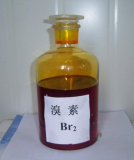Bromine Suppliers, Bromine Manufacturers.
Baipan (Shandong) Supply Chain Management Co., Ltd

Bromine
Category :
Inorganic chemicalsSynonyms :
Bromine solution;Bromine water;Bromine (Standard State);CAS NO :
7726-95-6EC NO :
231-778-1Molecular Formula :
Br2Molecular Weight :
159.808Main Specifications :
InChI :
InChI=1/Br2/c1-2Product description :
Product name: Bromine Alias: Bromine solution; Bromine water; Bromine (Standard State) CASE NO.: 7726-95-6 EINECS No.: 231-778-1 Molecular Formula: Br2 Molecular weight: 159.808 Inches: InChI=1/Br2/c1-2 Molecular structure: 
Density: 2.91g/cm3 Melting Point: -7.2℃ Boiling Point: 58.8°C at 760 mmHg Water solubility: 35 g/L (20℃) Vapor pressure: 190mmHg at 25°C Physicochemical properties: Property reddish brown smoky liquid.
Melting point -7.2℃
Boiling point 58.78℃
Relative Density 3.119 (20℃)
Solubility is slightly soluble in water, 3.58g/100ml water (20℃);
Soluble in ethanol, ether, chloroform, carbon tetrachloride, kerosene and carbon disulfide and other organic solvents;
It is also soluble in hydrochloric acid, hydrobromic acid and bromine compound solutions.
Element of Group 17 (VIIA).
Atomic number 35.
Stable isotope 79,81.
Density(liquid)3.119g/cm3.
Melting point -7.2℃.
Boiling point 58.8℃.
The main oxidation states are -1, +1, +5, +7.
Dark red liquid.
It is volatile.
It has a choking odor.
Toxic!
Burns the skin, severely irritates the mucosa and respiratory tract.
Slightly soluble in water.
Soluble in organic solvents.
Chemically less active than chlorine.
Can be combined with most metals and non-metals.
A strong oxidizing agent, bromine is found mainly in Marine water as alkali metal bromide.
It can be extracted from bromides in seawaterUses: It is mainly used for making bromide, and is used in medicine, pesticides, dyes, spices, photographic materials, fire extinguishing agents, mineral processing, metallurgy, tanning leather, water purification and other departments as ordinary analytical reagents, oxidants, absorbers of ethylene and heavy hydrocarbons and brominating agents for organic synthesis Hazard Signs: T+: Very toxic;
C: Corrosive;
N: Dangerous for the environment;Risk Terminology: R26: ;
R35: ;
R50: ;Security Terminology: S26: ;
S45: ;
S61: ;
S7/9: ;Upstream Raw Materials: Soda ash, sulfur dioxide, sulfuric acid, chlorine, chlorine (liquid), caustic soda, zinc Downstream Products: Hydrobromic acid, magnesium chloride, sodium bromite, sodium bromide, calcium bromide, lithium bromide, magnesium bromide, manganese bromide, sodium bromate, potassium bromate, potassium bromide, ammonium bromide, phosphorus tribromide, 2-bromopyridine, 5-cyanoindole, m-bromoanisole, tetrabromophthalic anhydride, tetrabromoethane, 2-chloro-4-bromophenol,1, 1-cyclobutane dicarboxylic acid, tenobuzole wettable powder, sodium tetraphenolate,1,
2-dibromoethane, hydrobromic acid, benzalammonium bromide, UV initiator 907, hydrazine bromideMolecular Structure :

World Wide ChemNet: - International - China - Korea
About Us - Top Products- Partner with Us - Contact Us - Help - Sitemap
About Us - Top Products- Partner with Us - Contact Us - Help - Sitemap
ChemNet is a registered trademark of Zhejiang NetSun Co., Ltd.
